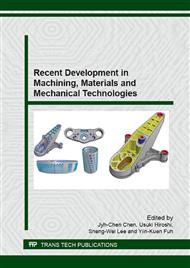p.387
p.391
p.398
p.404
p.410
p.416
p.422
p.428
p.434
Wear Monitoring of Steel Ball of a CNC Machining Centre by Using Surface Roughness of Finished Test Pieces
Abstract:
Currently, there are several methods for indicating wear of the steel ball and screw shaft components of CNC machining centres. These include wear prediction of the steel ball and screw shaft of the ball screw by using the value of backlash. This value, generally, has to be determined using expensive equipment such as a laser interferometer or a ball bar. In order to reduce the monitoring cost of ball screw wear, especially steel ball wear, a new monitoring technique is introduced. This technique was developed from a correlation between steel ball wear and the surface roughness of the machined surface of a test piece. In this research, the balls were subjected to artificial wear which were achieved by using a barrel tumbling process. Experimental results indicated that ball wear causes increase in surface roughness of a machined test piece. Employing these results, an equation for estimating steel ball wear was developed. Research results also showed that this new technique can reduce monitoring cost significantly compared with the cost of conventional methods.
Info:
Periodical:
Pages:
410-415
Citation:
Online since:
July 2015
Keywords:
Price:
Сopyright:
© 2015 Trans Tech Publications Ltd. All Rights Reserved
Share:
Citation:


